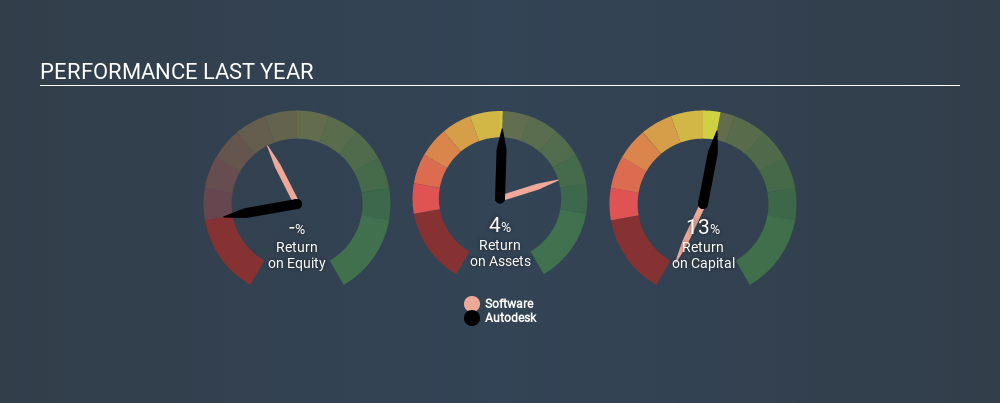
Today we are going to look at Autodesk, Inc. (NASDAQ:ADSK) to see whether it might be an attractive investment prospect. Specifically, we're going to calculate its Return On Capital Employed (ROCE), in the hopes of getting some insight into the business.
First of all, we'll work out how to calculate ROCE. Second, we'll look at its ROCE compared to similar companies. Finally, we'll look at how its current liabilities affect its ROCE.
What is Return On Capital Employed (ROCE)?
ROCE is a metric for evaluating how much pre-tax income (in percentage terms) a company earns on the capital invested in its business. In general, businesses with a higher ROCE are usually better quality. Overall, it is a valuable metric that has its flaws. Author Edwin Whiting says to be careful when comparing the ROCE of different businesses, since 'No two businesses are exactly alike.
How Do You Calculate Return On Capital Employed?
The formula for calculating the return on capital employed is:
Return on Capital Employed = Earnings Before Interest and Tax (EBIT) ÷ (Total Assets - Current Liabilities)
Or for Autodesk:
0.13 = US$292m ÷ (US$5.0b - US$2.8b) (Based on the trailing twelve months to October 2019.)
So, Autodesk has an ROCE of 13%.
View our latest analysis for Autodesk
Does Autodesk Have A Good ROCE?
One way to assess ROCE is to compare similar companies. In our analysis, Autodesk's ROCE is meaningfully higher than the 9.8% average in the Software industry. We consider this a positive sign, because it suggests it uses capital more efficiently than similar companies. Regardless of where Autodesk sits next to its industry, its ROCE in absolute terms appears satisfactory, and this company could be worth a closer look.
Autodesk reported an ROCE of 13% -- better than 3 years ago, when the company didn't make a profit. This makes us wonder if the company is improving. You can click on the image below to see (in greater detail) how Autodesk's past growth compares to other companies.

Remember that this metric is backwards looking - it shows what has happened in the past, and does not accurately predict the future. ROCE can be deceptive for cyclical businesses, as returns can look incredible in boom times, and terribly low in downturns. ROCE is only a point-in-time measure. Since the future is so important for investors, you should check out our free report on analyst forecasts for Autodesk.
How Autodesk's Current Liabilities Impact Its ROCE
Current liabilities include invoices, such as supplier payments, short-term debt, or a tax bill, that need to be paid within 12 months. The ROCE equation subtracts current liabilities from capital employed, so a company with a lot of current liabilities appears to have less capital employed, and a higher ROCE than otherwise. To check the impact of this, we calculate if a company has high current liabilities relative to its total assets.
Autodesk has total assets of US$5.0b and current liabilities of US$2.8b. As a result, its current liabilities are equal to approximately 56% of its total assets. Autodesk's current liabilities are fairly high, which increases its ROCE significantly.
The Bottom Line On Autodesk's ROCE
While its ROCE looks decent, it wouldn't look so good if it reduced current liabilities. There might be better investments than Autodesk out there, but you will have to work hard to find them . These promising businesses with rapidly growing earnings might be right up your alley.
If you are like me, then you will not want to miss this free list of growing companies that insiders are buying.
If you spot an error that warrants correction, please contact the editor at editorial-team@simplywallst.com. This article by Simply Wall St is general in nature. It does not constitute a recommendation to buy or sell any stock, and does not take account of your objectives, or your financial situation. Simply Wall St has no position in the stocks mentioned.
We aim to bring you long-term focused research analysis driven by fundamental data. Note that our analysis may not factor in the latest price-sensitive company announcements or qualitative material. Thank you for reading.
About NasdaqGS:ADSK
Autodesk
Provides 3D design, engineering, and entertainment technology solutions worldwide.
Excellent balance sheet with reasonable growth potential.
Similar Companies
Market Insights
Community Narratives




